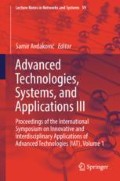Abstract
Minimally invasive surgery is a surgical method, which boasts many advantages over regular surgeries, such as decreasing the risks involved by minimizing the incision area, thus reducing the risk of infection compared to invasive surgeries. Laparoscopic surgery tools built for this purpose are mostly singular in function, which means that it requires multiple incisions for multiple tools or changing tools using the same incision during the operation. This project attempts to motorize an affordable multifunctional mechanical surgical tool prototype. The tool is designed using SolidWorks and controlled using MATLAB/Simulink. Three motors are used to motorize the multifunctional laparoscopic tool and their control architectures made it more precise and more accurate for noninvasive operations. It is shown that with some physical modifications and simple PID control, the multifunctional laparoscopy tool can be controlled and modified for the robotic-assisted surgery. Possible future improvements include attachment of the cameras and wireless control for the tele-operational applications.
Access this chapter
Tax calculation will be finalised at checkout
Purchases are for personal use only
References
Clarke, H.C.: Laparoscopy—new instruments for suturing and ligation. Fertil. Steril. 23(4), 274–277 (1972)
Hunter, P.: The cutting edge, a synergy of modern surgical techniques and science improves patient survival and recovery. EMBO Rep. 8(11), 999–1002 (2007)
Alexander, J.I., Hull, M.G.: Abdominal pain after laparoscopy: the value of a gas drain. Br. J. Obstet. Gynaecol. 94(3), 267–269 (1987)
Mirhashemi, R., Harlow, B.L., Ginsburg, E.S., Signorello, L.B., Berkowitz, R., Feldman, S.: Predicting risk of complications with gynecologic laparoscopic surgery. Obstet. Gynecol. 92(3), 327–331 (1998)
Jimenez-Rodríguez, R.M., Segura-Sampedro, J.J.: Laparoscopic approach in gastrointestinal emergencies. World J. Gastroenterol. 22(9), 2701 (2016)
Bhandarkar, D., Mittal, G., Shah, R., Katara, A., Udwadia, T.E.: Single-incision laparoscopic cholecystectomy: how I do it? J. Minimal Access Surg. 7(1), 17–23 (2011)
van der Westebring Putten, E.P., Goossens, R.H., Jakimowicz, J.J., Dankelman, J.: Haptics in minimally invasive surgery – a review. Minim. Invasive Ther. 17(1), 3–16 (2008)
Gallagher, A.G., McClure, N., McGuigan, J., Ritchie, K., Sheehy, N.P.: An ergonomic analysis of the fulcrum effect in the acquisition of endoscopic skills. Endoscopy 1(7), 617–620 (2007)
Rosser, J.C., Rosser, L.E., Savalgi, R.S.: Skill acquisition and assessment for laparoscopic surgery. Arch. Surg. 132, 200–204 (1997)
Taşkın, E., Kurt, E., Elitaş, M., Tansuğ, T.: Çok fonksiyonlu apendektomi cihazı, Otomatik Kontrol Ulusal Toplantısı (2017)
Frecker, M.I., Schadler, J., Haluck, R.S., Culkar, K., Dziedzic, R.: Laparoscopic multifunctional instruments: design and testing of initial prototypes. JSLS 9, 105–112 (2005)
da Vinci Surgery. http://www.davincisurgery.com/. Accessed 10 July 2017
Sallinen, V., Mentula, P.: Laparoscopic appendectomy. Duodecim 133(7), 660–666 (2017)
Budyans, R.G., Nisbett, J.K., et al.: Shigley’s Mechanical Engineering Design, vol. 9. McGraw-Hill, New York (2008)
Podsędkowski, L.R., Moll, J., Moll, M., Frącczak, L.: Are the surgeon’s movements repeatable? An analysis of the feasibility and expediency of implementing support procedures guiding the surgical tools and increasing motion accuracy during the performance of stereotypical movements by the surgeon. Kardiochirurgia i torakochirurgia polska=Pol. J. Cardio-Thorac. surg. 11(1), 90 (2014)
Riviere, C.N., Rader, R.S., Khosla, P.K.: Characteristics of hand motion of eye surgeons. In: Proceedings of the 19th Annual International Conference of the IEEE Engineering in Medicine and Biology society, vol. 4, pp. 1690–1693. IEEE (1997)
Author information
Authors and Affiliations
Corresponding author
Editor information
Editors and Affiliations
Rights and permissions
Copyright information
© 2019 Springer Nature Switzerland AG
About this paper
Cite this paper
Dabbour, A.R., Sabanovic, A., Elitaş, M. (2019). PID-Controlled Laparoscopic Appendectomy Device. In: Avdaković, S. (eds) Advanced Technologies, Systems, and Applications III. IAT 2018. Lecture Notes in Networks and Systems, vol 59. Springer, Cham. https://doi.org/10.1007/978-3-030-02574-8_30
Download citation
DOI: https://doi.org/10.1007/978-3-030-02574-8_30
Published:
Publisher Name: Springer, Cham
Print ISBN: 978-3-030-02573-1
Online ISBN: 978-3-030-02574-8
eBook Packages: Intelligent Technologies and RoboticsIntelligent Technologies and Robotics (R0)

